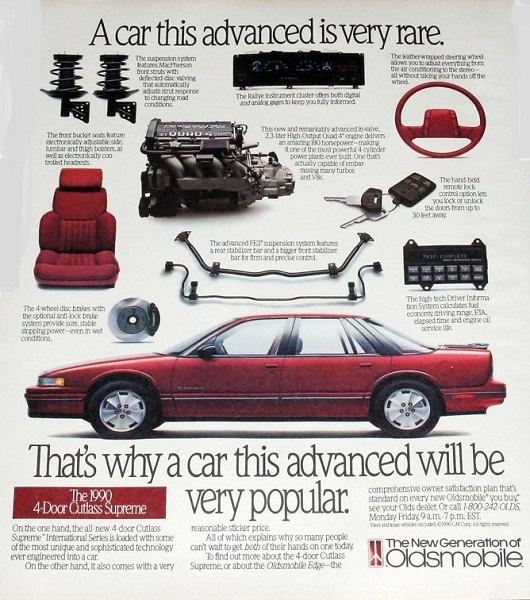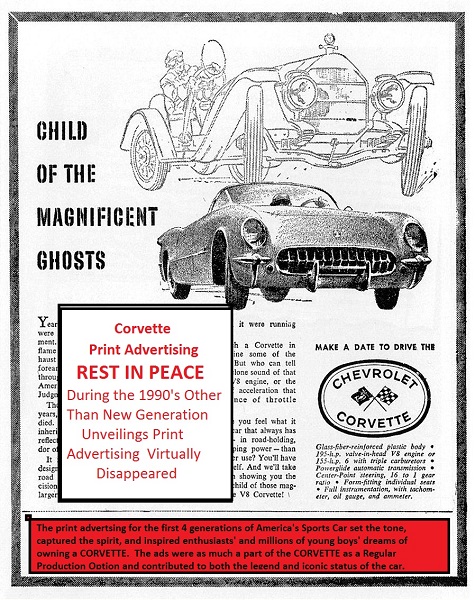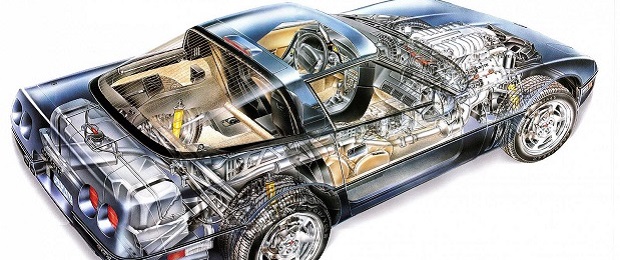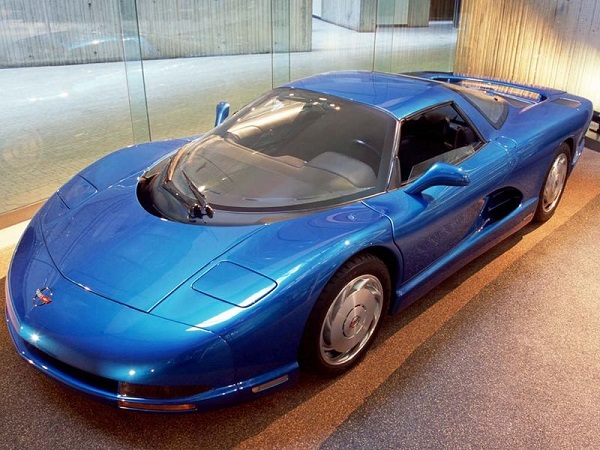Corvette History through Ads: Where Did All the Corvette Ads Go?
No, the images are not a mistake! Each week for over a half year you have grown accustomed to seeing a Corvette advertisement as the opening to this series of articles detailing the history of the Corvette through advertising. And it is no error that in order to grasp this important part of the Corvette’s history one must understand that in the early 1990’s Corvette display advertising virtually ceased to exist.
It set a precedent for marketing the Corvette and has affected print advertising for America’s sports car ever since. It may seem hard to believe especially since Corvette print advertising was as much a part of the first four generation Corvettes as an RPO, especially to enthusiasts over 45 years old. The ads were creative, informative and connected with enthusiasts and potential buyers. But if you don’t believe it, dig out some 1992 or later enthusiast magazines like Car & Driver and look for a Corvette advertisement. You’ll most likely find several GM ads none of which feature the Vette. In all probability, the only Corvette you will find in advertisements will be in tire ads. I went through several and couldn’t find one corporate ad for a Corvette. There were several ads for GM’s high volume cars like the Oldsmobile Cutlass and for the high profit cars like the Cadillac Seville and Oldsmobile Toronado Trofeo. Though extraordinary refinements were being made to one of the finest sports cars in the world, the ZR1, after the initial introductory ads in late 1989 and 1990 there were few if any ads to proclaim the Corvette’s return to its performance heritage. Why? Read on.
During the late 1980’s to mid 1990’s the Corvette’s future was once again in jeopardy, the car came disturbingly close to be cancelled. The ZR1 extended the life of the aging C4 Corvette design and breathed new life into the current generation, which had already been in production for almost 7 years and due to be replaced in 1993. The new C5 was already under development and scheduled for a 1993 introduction to coincide with the Corvette’s fortieth anniversary but by the beginning of the 1990’s things inside General Motors took a dramatic but not wholly unexpected turn.
Roger Smith, CEO, had been making drastic changes in the corporation as he neared retirement. He was driven to insure that his legacy would live on well past his retirement and as a result made changes throughout the corporation to everything from the ways cars were built, the factories they were built in, and the approval and process required to get a vehicle produced. One of his goals was to achieve record profitability before he left and one of the steps he took to achieve this was to embark on a dramatic cost cutting effort to milk as much profit as possible, known in business as “milking the cows and eating the calves.” And although Smith was able to achieve his goal, it came at a high cost, mortgaging future results and wreaking havoc throughout the corporation, almost bringing the corporation to bankruptcy shortly after he retired. His profitability strategy did succeed for 1988, earning almost $5 billion, the most profitable year in the corporation’s history until recently. Though Smith’s plan did succeed for the year, the longer term outlook was anything but encouraging. Some of Smith’s decisions had left the company vulnerable in a difficult economy and by the time he turned the corporation over to Bob Stempel, his chosen successor, in 1990, GM had managed to lose almost $2 billion, which doubled the following year and then skyrocketed to a staggering $24 billion loss in 1992. In only two short years since Smith’s record breaking profitability the corporation was losing billions annually.
By the time Stempel, a former engineer, had assumed the chairman position it was his job to return the corporation to profitability and sort out and resolve the crisis he had inherited from his predecessor. The overwhelming task would challenge even the most experienced corporate leader, but it took its toll on the rookie chairman as he searched for ways to stop the bleeding. Overwhelmed by the challenge, one of the ways he tried to resolve the mounting red ink was to turn more control over to the “bean counters” in an attempt to get even more costs out of the operations. The “bean counters” slashed several programs, some deservedly and others not, to try and reduce expenses. In their zeal they did almost irreparable damage to the world’s largest automobile manufacturer. The financially focused decision-makers dictated policies based solely on cost, not quality or longevity, which resulted in poorly made vehicles and which further confused and demoralized workers at all levels. Plants were closed, union and management employees at all levels were laid off, departments were consolidated and reorganized, more often than not, well beyond the point of peak efficiencies.
Every program within the corporation was examined for cutbacks, consolidation and downsizing whether profitable or not, all in a frenzy to cut costs and maintain sales of their profitable high volume and high margin cars, under attack from imports. Now, not only was General Motors losing massive amounts of money but they were also losing respect throughout the automotive world for shoddy quality and company morale was at an all time low from the constantly changing business plan and almost weekly reorganization efforts.
And even though the low volume Corvette was both profitable and the expenditure for the entire program was relatively small, it was not immune to cutbacks. And so, even though the Corvette was operating “in the black,” it came as a surprise when Bob Stempel announced in a high level executive conference in the fall of 1989 that the Corvette development program was “now on indefinite status.”
Many of those in attendance were demoralized but no one was really sure exactly what he meant. But in the austere, cost cutting environment that permeated the corporation anything on “indefinite status” was as good as gone. It appeared that, minimally, all of the C5 development would cease and possibly it meant that the costs for maintaining programs to support the current C4 would also be cut. Insiders realized that the aging C4, even with the ZR1, could not compete much longer and if the development of the C5 was cancelled, it virtually meant the end of the Corvette.
Getting a new C5 to the market was clearly the only way the Corvette would survive so the team had to devise a way to continue the design and development of the C4 replacement. One of the advantages of being a small program in a large corporation is that it is often possible to just keep doing what you have been doing as long as you keep a low profile and stay under the radar. Obviously in the largest corporation in the world, and one losing $24B a year, there were bigger “fish to fry” than the relatively tiny Corvette program.
It was obvious that the Corvette had several loyal supporters within the organization at all levels and they did not want to see America’s sports car terminated. So those committed managers associated with the Corvette decided to just continue what they were doing but to do it more quietly and use a little “creative accounting” to hide any costs associated with the C5 development. But operating “under the radar” and with no development budget it was clear that the C5 could never meet the original target date for a 1993 introduction.
Throughout the corporation things were so bad, moral so low, and with the organizational changes taking place almost on a daily basis no department or individual could be held accountable. Reporting relationships were often blurred and circumvented. Deadlines were a moving target and resulted in delayed new model introductions. The new Camaro, with the design and engineering almost complete when the cutbacks were instituted and much further along than the still undeveloped C5, was due to be in dealerships in 1992 and still did not reach the showrooms until late in 1993. Clearly the Corvette team, operating “under the radar” and with no official development budget, could never meet the original target date for a 1993 introduction.
From one day to the next the designers and engineers assigned to the Corvette program were not sure whether or not they would have a job when they came to work. On more than one occasion the Corvette program had the budgets cut so severely that even being able to fund programs necessary to maintain the C4 seemed impossible. And yet most of the engineers and designers assigned to the Corvette continued to throw themselves into their jobs and work long hours to insure that America’s sports car would live on. (In this brief article the truly heroic efforts of the Corvette team to save their car cannot be adequately covered and if you want to learn more about what it took to get the C5 to market I suggest reading James Schefter’s excellent account in All Corvettes Are Red).
It was only through their dedicated efforts along with a few other executives that managed to save the most iconic car in America. It was guys like Joe Spielman, head of North American Midsize vehicles (including Corvette), Jim Perkins, Chevrolet General Manager, Dave McLellan and Dave Hill, Corvette Chief Engineers, Cardy Davis and Russ McLean, Corvette Program Managers, Jerry Palmer, Executive Director of Advance Design, John Cafaro, Studio Chief of Chevy #3 (Corvette), Tom Peters, Studio Chief of Advanced Design, and perhaps one of the most important and little recognized team members–Tom Krejcar, Corvette Financial Manager, who put his job on the line by bending the rules, ignoring some directives, and finding new ways to creatively code C5 expenses to fund the continued development of the C5. The salaries and expenses of several of the engineers and all of the administrative staff which contributed to the development of the C5 were actually charged to the C4. Higher level executives that loved the Corvette and wanted it to continue “officially” didn’t know what the Corvette team was doing and closed their eyes to the continuing work on the replacement car.
Several executives, engineers and designers literally put their careers on the line to be able to continue the C5 development. Jim Perkins, Chevrolet’s GM, believed and openly proclaimed, “There is a little Corvette in every Chevrolet.” In order to help save the Corvette he went as far as to divert $1M from Chevrolet’s budget to help finance the much needed replacement Corvette. He knew well the importance of the Corvette in driving other Chevrolet sales. And though that may not sound unusual to anyone who does not understand General Motors organizational structure, car manufacturers like Chevrolet, Buick, and Cadillac do not develop or fund models. The divisions within GM are “marketing organizations” and vehicle development is strictly GM’s responsibility. It was a ballsy move on Jim’s part and one of the reasons we have a Corvette today and also one of the reasons Jim is in the National Corvette Museum’s Hall of Fame.
In all probability it was the budget reallocations and cutbacks, the need to creatively find money to fund the C5 development as well as the need to keep a “low profile” that caused the disappearance of Corvette advertising from magazines except during new generation unveilings. Sales fell off in the early 90’s, slipping from approximately 26K cars in 1989 to a little over 20K cars annually in 1991 and 1992. It is impossible, however, to attribute all of the lost sales to advertising cutbacks, though there is little doubt that it was a major factor. What cannot be accurately calculated is the net profit impact the reduced advertising cost had in relation to the reduced sales. But we must also remember that the C4 was over seven years old in 1991 so part of the slip in sales can be attributed to aged model.
The quality and effectiveness of the Corvette’s marketing is a subject that has been debated for years, and the lack of advertising is one of the major topics frequently brought up. Even today most of the marketing for the Corvette is put into event sponsorship as opposed to print and TC advertising. During the televised coverage of the Rolex® 24 Hours of Daytona, which the Corvette won their class, there was no TV advertising to promote the Corvette. Other Chevrolet models were advertised but not the Corvette even though Porsche and the SRT Viper both advertised throughout the race.
So the advertisement opening this article is no mistake, it was these models that GM was promoting. Understanding this era in the Corvette’s history is not only important but also offers a better perspective to perhaps the most critical events affecting the future of the car. It also illustrates the outstanding quality and commitment of the Corvette team in not only keeping the Corvette alive but at the same time designing and building a beautiful, performance based Corvette that raised the bar for all future generations. Understanding this part of Corvette history gives the Corvette lover a deeper appreciation realizing how close we came to losing it, who was responsible for saving it and why award-winning Corvette advertising that were so much a part of the first four generations vanished.




